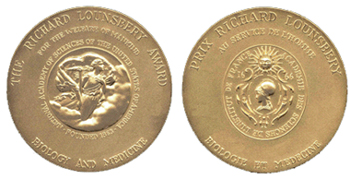|
Awards
Richard Lounsbery Award

Intended to stimulate research and to encourage reciprocal scientific exchanges between the United States and France, this prize is given in alternate years to young American and French scientists in recognition of extraordinary scientific achievement in biology and medicine. In addition to the award, a further sum is provided for the recipient to visit a laboratory or research institution in France, if he or she is American; in the United States, if French. The recipient is invited to give a lecture at the Academy that awards the prize. Established by Vera Lounsbery in memory of her husband, Richard Lounsbery. Scheduled for presentation in the year 2007 to a young American scientist.
Recipients:
Michael S. Brown and Joseph L. Goldstein (1979)
For their work in cholesterol biosynthesis.
François Morel (1980)
For his work on the physiology of the kidney.
Philip Leder (1981)
For his series of notable contributions in molecular genetics, which help to explain the means by which genetic information is organized and used to direct the synthesis of specific cell products.
Pierre Chambon and Jean Pierre Changeux (1982)
For their work on fundamental structures of genetic material and of the nervous system.
Günter Blobel (1983)
For his work in uncovering the molecular interactions that control the traffic of newly synthesized proteins in eukaryotic cells, for his incisive experiments, and for the beauty of the findings by which he established these interactions.
Maxime Schwartz (1984)
For his genetic and biochemical analysis of the maltose system of E.Coli, which paved the way for the solution of a series of fundamental problems in molecular biology.
Martin Gellert and Thomas Maniatis (1985)
For their seminal contributions to our understanding of the structure and function of DNA, which were essential and fundamental to the development of recombinant DNA techniques.
André Capron and Jacques Glowinski (1986)
For their fundamental work, which has contributed to the treatment of parasitic and neurological diseases.
Alfred G. Gilman and Martin Rodbell (1987)
For their discoveries regarding the proteins and mechanisms that mediate cellular responses to the binding of ligands to cell surface receptors.
François Cuzin (1988)
For his original contributions in the elucidation of the mechanisms involved in malignant cell transformation, in particular, demonstration of the necessary contribution of two oncogenes.
Richard Axel (1989)
For his discoveries elucidating gene structure in animal cells.
Jean Rosa (1990)
For his contributions, which have opened a new road in the control of oxygen transport in the blood and the treatment of the first worldwide genetic plague, drepanocytosis.
Marc W. Kirschner (shared, 1991)
For elucidating key steps in the cell cycle, chromosome movement, cell cycle timing, nucleus breakdown and reformation, and microtubule control of cell polarity and mitosis.
Harold Weintraub (shared, 1991)
For elucidating a molecular mechanism by which a single regulatory gene can lead to a program of cell differentiation.
Philippe Ascher and Henri Korn (1992)
For their discoveries of the mechanisms of synaptic transmission. Philippe Asher furthered knowledge regarding the properties of glutamate receptors which play an important role in trials, and Henri Korn brought to light the elementary liberation of neurotransmitter in quanta form in the central nervous system of vertebrates.
Stanley B. Prusiner and Bert Vogelstein (1993)
For distinct and exciting discoveries about the pathogenesis of neurodegenerative and malignant diseases. This award is given as a celebration of the power of modern molecular medicine.
Jean Louis Mandel (1994)
For his work in human genetics and in particular for his discovery of the mutation of fragile X. This new type of mutation has now been found at the origin of the diseases.
Douglas A. Melton (1995)
For showing how cells and tissues differentiate during vertebrate development through studies on localized mRNAs in eggs and the genes that induce mesoderm and neural tissue.
Daniel Louvard and Jacques Pouysségur (1996)
For their contributions to the study of the regulation of cell division and differentiation.
James E. Rothman (1997)
For a dissection of the biochemical mechanisms by which proteins are transferred from one cellular compartment to another and to the outside world. These mechanisms are important in neurotransmission, tissue biogenesis, and hormonal secretion.
Pascale Cossart (1998)
For her fundamental discoveries in microbiology dealing with mechanisms of bacterial entry and intracellular host motility.
Elliot M. Meyerowitz (1999)
For his pioneering contributions to the molecular genetics of plant architecture, which have practical implications for agriculture.
Miroslav Radman (2000)
For his contribution to the discovery of the molecular mechanisms implicated in the replication and repair of DNA. In particular, he discovered a key enzyme of the DNA repair mechanism.
Elaine Fuchs (2001)
For fundamental insights into structure and function of cytoskeletal proteins and the relation of these proteins to human genetic diseases.
Denis Le Bihan (2002)
For his work on the invention and development of nuclear magnetic resonance imaging of brain diffusion and perfusion. The method he developed permits in vivo mapping of nerve fiber bundles and has multiple applications in both medical pathology and cognitive science fields.
Carol W. Greider (2003)
For her pioneering biochemical and genetic studies of telomerase, the enzyme that maintains the ends of chromosomes in eukaryotic cells.
Brigitte Kieffer (2004)
For her pioneering work on the molecular neurobiology of opioid-controlled behaviors. Her results have very important implications for the treatment of pain, drug abuse, and emotional disorders.
John Kuriyan (2005)
For his critical role in revealing the structural mechanisms underlying processivity in DNA replication and the regulation of tyrosine kinases and their interacting target proteins.
Catherine Dulac (2006)
For major contributions in the perception and behavioral translation of pheromones in mammals.
|
|
|